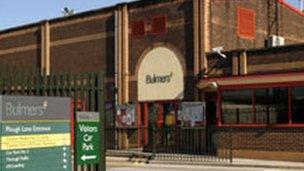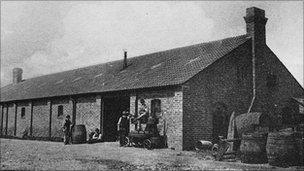Bulmers seek permission to demolish historic 50s mill
- Published

Bulmers employs more than 400 people at its two sites in Hereford
Cider-maker Bulmers has applied for planning permission to demolish old facilities at one of its sites in Hereford.
The Plough Lane site was first used by the firm in the late 1930s but moved its milling and processing facilities to a new base in Ledbury in 2008.
The millhouse was later condemned as modern ways of working became too much for the outdated building.
The firm wants to demolish its mill, evaporation plant and dryer house.
'Always cutting edge'
It also wants to remove the weighbridge, office and apple canal.
Spokesman Gabe Crook said: "The process was more labour-intensive in the 20th Century.
"About 28 to 30 tonnes were tipped into a pool if you like, and the fruit was carried along conduits using water and washed along the way to the mill and then pressed - it's not canals now.
"Whatever technology we have, it's always cutting edge, even years ago, we were at the forefront."
The company stems from H P (Percy) Bulmer, the youngest son of the Rector of Credenhill, first pressing apples for his father's orchard in 1887.
The following year, Percy rented a warehouse in Maylord street, Hereford, and arranged to buy apples from local farmers, and produced 4,000 gallons of cider.
In 1889 the firm expanded and moved to Ryelands Street, where Percy was joined by his brother Fred, who was in charge of sales.

In 1889 Bulmers expanded and moved to Ryelands Street in Hereford
The flourishing business saw it being awarded a Royal Warrant in 1911.
In the 1930s, facilities were built at the Plough Lane site and then the company moved its mill and pressing facilities to Ledbury in Hereford in 2008.
The firm now has the largest pressing mill in Europe.
The industry has seen a huge resurgence in popularity over the past few years and from the firm's humble beginning in the late 1800s, it's now an integral part of a multi-million pound market.
"The millhouse (at Plough Lane) has now been condemned," said Mr Crook.
"It was over two or three floors and the load on girders made it unsafe and our thoughts on the future business and growth, it made sense to move.
"But the methods have not changed in last 20 to 30 years.
"The millhouse was built in the 1950s and the first automated pressing technology came in in 1960s and 70s.
"That was again updated in the late 80s - early 90s so there was a mix of old and new there.
"And now after the resurgence which was in about 2006 - a hot summer, the World Cup was on and Magners had a huge marketing campaign that had the gimmick over drinking it over ice - a new generation was introduced to cider.
"The market grew by 50%."
With more 400 people employed at the two sites, a further 200 are contracted indirectly and 200-300 used ad hoc, Mr Crook said.
"We use 10,000 acres in Hereford and surrounding counties which equates to a third of all apples grown in England, whatever type they are.
"Growers are given 25 to 30-year contracts and they bear the costs up front and benefit, or break even, in year-seven then it's all profit for them.
"We promise to buy every apple they produce at a pre-agreed price so it's a long-term investment for them.
"The recent boom in sales of cider was reason enough for Bulmers to plant another 1,200 acres to take us up to the 10,000.
"That's 400 new trees over three years - 2008/9/10 so we're just seeing the benefit of that now."
As the firm looks to the future as the industry continues to blossom, part of its cider-making past looks likely to be demolished in the next three months if permission is granted.
The company's packaging and distribution arm is at Plough Lane and the site is a key part of its history.
"It's our heart and home," Mr Crook added.
It is not clear what the company will do with the land after the demolition takes place.